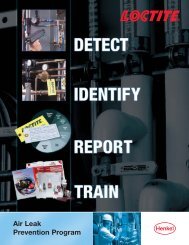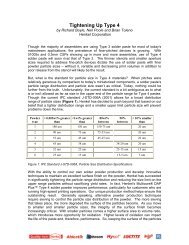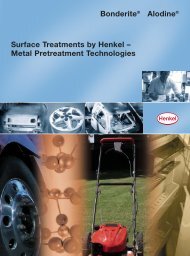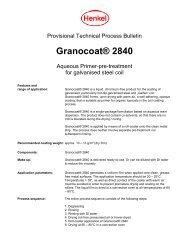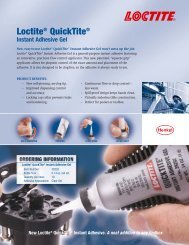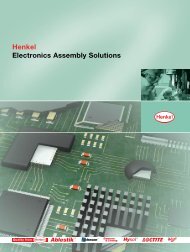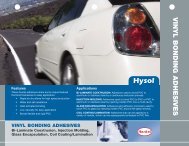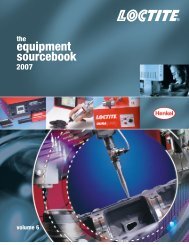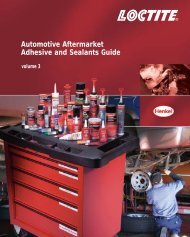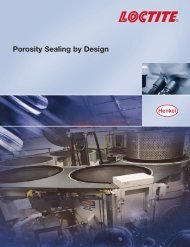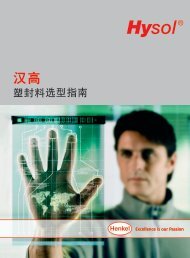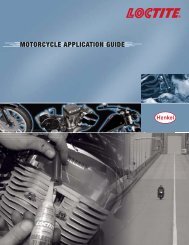SOUND ENGINEERING FROM - Loctite.ph
SOUND ENGINEERING FROM - Loctite.ph
SOUND ENGINEERING FROM - Loctite.ph
- No tags were found...
You also want an ePaper? Increase the reach of your titles
YUMPU automatically turns print PDFs into web optimized ePapers that Google loves.
Assembling Speakers with <strong>Loctite</strong> ® AdhesivesVoice Coil to Spider to ConeIn most cases, this is considered a single bond,although it is sometimes accomplished in two separatesteps, as two bondlines, and in some cases, uses two differentadhesives. This text assumes the most commonsituation: one step, one bondline, and one adhesive.Cyanoacrylates, or instant adhesives, are the productsof choice, particularly the newer thermal resistantproducts which work well where added temperatureresistance is needed. Cyanoacrylates are fast, simpleand the perfect compliment to high speedmanufacturing lines.Paper cones tend to be very porous, and as theirmoisture content changes, the speed of cure of cyanoacrylateswill change. Very low moisture conditionstend to slow the cure, while very high moistureconditions accelerate it. Variations in paper chemistrycan create pH shifts in the cone, and can affect the speedof cure with cyanoacrylates. <strong>Loctite</strong> ® PRISM ® surfaceinsensitive cyanoacrylates work extremely well, over arange of humidity and pH conditions.No matter how experienced the user is, polypropylenecones always present a bonding challenge.Preparation is the key to success. Polypropylene is adifficult surface to wet since it has very low surfaceenergy, but this characteristic can be overcome withsuitable treatment. Several techniques are in use withinthe loudspeaker industry, including corona discharge,blown plasma arc, flame treating, and the use ofchemical primers to enhance surface energy. Whilechemical primers are the most common technique used,plasma etching can produce extremely high bondstrengths. The plasma technique uses an inert gasRF plasma generator to blow an arc of blue plasma ontothe bond area of the cone. Bonding with cyanoacrylateadhesives must take place within a minute for optimumresults. Some localized cosmetic pitting (dulling) of thesurface is normally evident, so the plasma must beconfined to the bond area only. The final bond strengthobtained with the plasma technique is high, as is thehardware investment.The chemical alternative can be as simple asspraying a <strong>Loctite</strong> ® Polyolefin Primer onto the substrateto be bonded and allowing it to evaporate. Or theprocess might call for pre-cleaning the area with acetoneand then mechanically abrading it. The most effectivehigh speed on-line compatible approach may bemechanical abrasion of the bond area, followedpromptly by an application of <strong>Loctite</strong> Polyolefin Primer.This routine lends itself to simple automation and offersexceptionally high bond strength. The effect of theprimer should not be underestimated, as bond strengthsare often 25 to 40 times higher than those achieved whenusing the same adhesives without primer.The cone-coil-spider bond is probably the mosthighly stressed in any given driver, often subjectedto simultaneous shear and cleaving forces, and alsoelevated temperatures. Attention should be paid to thethermal limit of the adhesive, not only the maximum"peak" temperature rating, but also the time-versus-temperatureinformation, which yields much more usefuldata. <strong>Loctite</strong> ® thermally resistant cyanoacrylates workwell on most known bobbin and collar materials, andtolerate sustained high temperature operation (particularlyproduct 4204) much better than any previous typesof cyanoacrylates. These products offer minimal massand easy dispensing, creating a very strongcone-coil-spider bond. Some have high temperatureresistance plus rubber-toughened properties, allowingthem to take peel and cleaving stresses in stride.One production technique that has proven beneficialis spider to coil pre-fixing. It involves adhesive-fasteningthese parts together off-line, using a simple jig. Becausethe coil and spider subassembly is not built in the driver,it can be inspected to ensure that the spider is perfectlylevel and is seated at the right height on the bobbin.If required, additional reinforcing bonds can be placed.12



